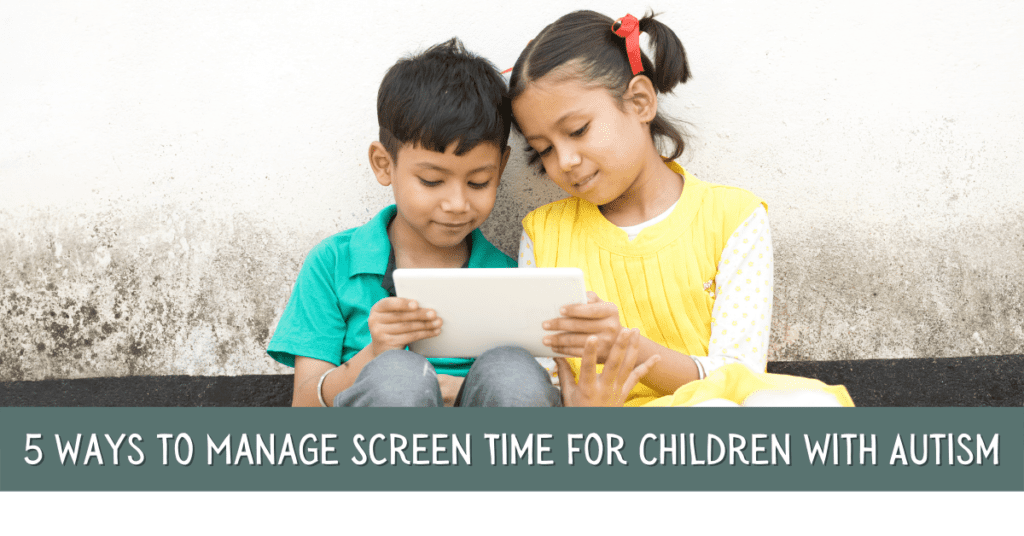
Many kids with autism prefer activities in solitude rather than with other peers. Screen use is a big preference among these activities, as you and so many other parents can probably attest. In fact, kids and teens with autism tend to spend more time engaging in screen activity than their neurotypical peers.
Managing screen time is a common battle for all parents, and particularly parents of children with autism. You may wonder how much screen time is too much, or perhaps you are desperate for ideas to avoid the screen time battle with your child. Maybe eliminating screens altogether feels like your only option to ensure your child will engage in anything else interactive. While it’s unrealistic to try and rid screens from kids’ lives completely, there are plenty of ways to monitor time spent on them. Screens don’t need to be demonized, but rather managed and used with good boundaries to preserve physical, psychological, social and neurological health.
Screens don’t need to be demonized, but rather managed and used with good boundaries to preserve physical, psychological, social and neurological health.
Let’s look at the pros and cons of screen time and some methods of management so your child can live their best quality of life.
Pros and Cons
Pros of screen time? It might seem unlikely, but they exist. Technology is an incredible tool that we’re blessed to have in our lifetime. Screen activities offer:
- Motivation (utilize screens as motivators for performing less preferred activities)
- Connection with friends and family
- Educational content
- Learning opportunities (discussing current events, emotions, communication, how-to videos)
On the other hand, and of which many of us are aware, cons of screen time include:
- Poor sleep
- Higher risk for ADHD-related behavior
- Impaired vision
- Impaired social skills
How to manage screen time
With screens so readily available to us all these days, we often have to set our own boundaries for healthy use. We all mindlessly use them more than we probably want unless we have a clear intention for use. Thus, teach and model intentionality in screen use for your child. Try these specific intentional methods of managing screens for more mindful use and better health.
1. Designate screen use areas
Designate areas of your home for screen use to set physical boundaries on appropriate use. You could establish rules such as keeping tablets and laptops at desks and living areas only. Setting boundaries on the location of use can help kids be aware of social setting expectations and to focus on one activity at a time. (Not to mention, location boundaries keep electronics safe from areas prone to messes, such as the kitchen.)
2. Create schedules
Come up with a schedule that includes slots for screen time or choose a time limit. For example, one hour on weekdays and 3 hours on weekends. Setting timers and giving warnings for how much time is left are helpful tools for easing transitions as well.
3. Monitor
This is an obvious one to many parents. Manage electronic devices with passwords, know exactly what your child is doing on the screen, and check age-appropriateness of the material.
4. Model healthy boundaries
Kids watch us as adults, and especially as parents, whether we realize it or not. Your screen use behaviors directly influence your child’s behaviors. Model healthy screen use boundaries for them, such as having no phones at the dinner table or during family time. A big one is avoiding multitasking while a screen is in front of you. Kids with autism may already have trouble with focus so demonstrate keeping your attention on one activity at a time.
5. Self-empower with self-monitoring
Ease the burden of managing screen time with your child with autism by involving them in self-monitoring. This way, it’s not just you holding all the power and “keys” to fun. If possible, engage in discussion with your child about what appropriate screen time looks like, including content, time length, relation to other activities, etc. In our technology saturated world, empowering your child to self-monitor is a valuable lesson they could take with them into the rest of their lives.
On a final note, be sure to inform your child’s BCBA or counselor of any screen time rules at home to implement during therapy to maintain behavioral consistency. Screens are a huge reinforcer for many in-clinic kids at Healing Haven so make sure screen time rules at the clinic don’t interfere with home expectations.
Additional Resources
If you’re looking for more help in the area of managing screen time for your child (with or without autism), we have an article over on Metro Parent with tips from our Director of Clinical Standards – Reducing Screen Time (and Replacing with Play!) for Your Child With Autism.
And this post over on MyTutor – The Screen Time Diet: helping your teen find balance with their tech – lists out some “good” screen time options and finding balance as a family.
